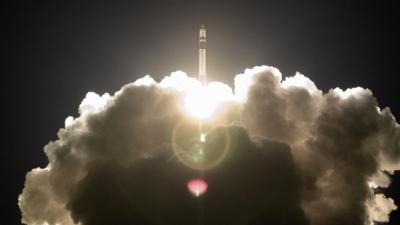Launch Was Rocket Lab USA’s Fifth Orbital Mission Overall And Second Orbital Mission Of 2019
The U.S. Air Force and its mission partners successfully launched three Department of Defense research and development satellites on Huntington Beach, California-based Rocket Lab USA’s Electron rocket from Mahia, New Zealand, May 4-5.

The DoD Space Test Program, under Air Force Space Command’s Space and Missile Systems Center, procured the mission in partnership with Defense Innovation Unit as part of the Rapid Agile Launch Initiative. This initiative leveraged DIU’s Commercial Solutions Opening process to competitively and rapidly award DoD launch service agreements with non-traditional, venture-class companies. The Rocket Lab USA launch is one of several planned launches in 2019 that will demonstrate the ability of the emerging launch industry to provide responsive, affordable space access for the Air Force and DoD.
This was Rocket Lab USA’s fifth orbital mission overall and second orbital mission of 2019. The mission flew Rocket Lab USA’s heaviest payload manifest to date, over 180 kg (397 pounds), from Mahia, New Zealand to a circular mid-inclination orbit of 500 km (310 miles).
“I’m thrilled with this weekend's successful launch,” said Col. Ben Brining, DoD Space Test Program director. “Our mission with Rocket Lab USA demonstrated an exciting new way to accelerate space capabilities by partnering with the emerging small launch industry. This mission typifies the objectives of SMC 2.0.”
The DoD experiments onboard the Rocket Lab USA launch will demonstrate advanced space technologies and accelerate the fielding of future operational space capabilities.
The Space Plug and Play Architecture Research CubeSat-1, or SPARC-1 mission, sponsored by the Air Force Research Laboratory’s Space Vehicles Directorate, is a joint Swedish-U.S. experiment to explore technology developments in avionics miniaturization, software defined radio systems and space situational awareness.
The Falcon Orbital Debris Experiment, or Falcon ODE, sponsored by the U.S. Air Force Academy, will evaluate ground-based tracking of space objects.
Harbinger, a commercial small satellite built by York Space Systems in Denver and sponsored by the U.S. Army Space and Missile Defense Command, will demonstrate the ability of an experimental commercial system to meet DoD space capability requirements.
The DoD Space Test Program, located at Kirtland Air Force Base, New Mexico, is part of Space and Missile Systems Center’s Space Development Corps.
The Space and Missile Systems Center, located at Los Angeles Air Force Base in El Segundo, California is the U.S. Air Force's center of acquisition excellence for acquiring and developing military space systems. Its portfolio includes the development of advanced space and launch capability and systems, global positioning systems, military satellite communications, defense meteorological satellites, space launch and range systems, satellite control networks, space-based infrared systems, and space situational awareness capabilities.
(Source USAF news release. Image provided with Rocket Lab news release)
 ANN's Daily Aero-Term (04.20.24): Light Gun
ANN's Daily Aero-Term (04.20.24): Light Gun Aero-News: Quote of the Day (04.20.24)
Aero-News: Quote of the Day (04.20.24) ANN's Daily Aero-Linx (04.21.24)
ANN's Daily Aero-Linx (04.21.24) Aero-News: Quote of the Day (04.21.24)
Aero-News: Quote of the Day (04.21.24) ANN's Daily Aero-Term (04.21.24): Aircraft Conflict
ANN's Daily Aero-Term (04.21.24): Aircraft Conflict



